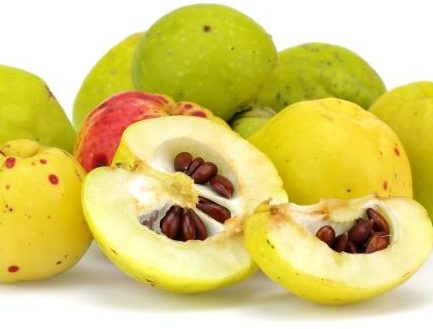Japanese quince (Chaenomeles) is a shrub that is most often used as an ornamental plant (it has unusually bright orange-red flowers). However, its fruits are edible and very healthy.

- Chaenomeles is the fruit of a Japanese or flowering quince. The shape is a ball with an upper part protruding like a mushroom cap.
- Sizes – from 4 to 15 cm in diameter, in the center are small elongated seeds of brown or black color.
- Peel – thin, smooth, light green, yellow, orange, peach, brown blotches are allowed, pulp – dense, light yellow, greenish, white, juicy; taste – tart, slightly astringent, sourish.
- The more ripe the fruit, the higher the calorie content due to the increased sugar content. However, the nutritional value does not change significantly.
- The pulp contains a large number of pectins – these substances have antioxidant and antitoxic effects. When it enters the human digestive tract, they form a gel that envelops harmful compounds, which are subsequently removed naturally.
- They are especially appreciated for their high content of vitamin C. That is why Chaenomeles is also called a northern lemon.
- Chinese healers recommend activating the vital energy of qi by eating ripe quince. To do this, thin slices are coated with honey and dissolve in the mouth during meditation. The healing effect is used not only in philosophical movements.
- Improves bowel function, protects its mucous membrane from the aggressive effects of gastric juice and bile acids. Increases the speed of peristalsis, restores the balance of intestinal microflora, increases appetite, and helps to get rid of intoxication.
- Possesses immunomodulatory and immuno-strengthening properties, during the season of epidemics prevents complications if they are still sick. Increases the overall resistance of the body.
- Stimulates the work of the hematopoietic system, increasing blood clotting. Normalizes the function of internal organs – liver and spleen. Stabilizes the pulse rhythm.
- Chaenomeles can be used as an external agent to prevent purulent-inflammatory processes and accelerate epithelialization with long-lasting non-healing scratches.
- The beneficial properties of Chaenomeles depend on ripeness. The longer the quince ripens on the tree, the more active the bio-properties.
13. Of course, quince can be used to make jam or jam; in general, it is also suitable for making competes.
Or you can freeze it (after cutting it into pieces) in order to take it out in winter and brew it in a thermos (like a rosehip).
